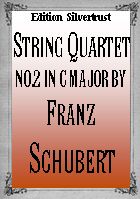Presents
Franz Schubert
 |
|
String Quartet No.2 in C Major, D.32
Franz Schubert (1797-1828), one of the most famous composers of all time, requires no introduction. However, his first six string quartets are virtually unknown and rarely heard let alone played. To learn more about their background and why that is Click Here.
Franz Schubert's String Quartet No.2 in C Major was composed in September 1812 while Schubert was at home on summer vacation. After Schubert’s death, the loose-leaf sheets upon which it had been written came into the possession of his brother Ferdinand. Two years later, Ferdinand sold them, along with much else, to the music publisher Anton Diabelli. Neither Diabelli nor his successors (Spina, Schreiber and Cranz) ever chose to publish the work. By the time the Gesamtausgabe editors began work (1890), one of the four completed movements as well as part of a second had been lost. The editors therefore only chose to publish the completed movements. (There had also been a partially completed fifth movement, apparently Schubert’s first thought for a slow movement) The missing pages eventually did turn up in the collection of a German diplomat and the complete quartet was eventually brought out in the 1950's.
In the first movement, Presto, the compositional technique resembles that used by Haydn, i.e. the taking of a fragment and developing it into a theme. The fragment is a mere dotted half note followed by a triplet. After several unisono passages, which serve a longish introduction, some but not all of the theme is finally given out. As the movement progresses in this fashion, the triplets take on a life of their own, as in his Great C Major Symphony, and become part of the theme. Though it seems to be impending at points, a second theme is never introduced. The second movement, Andante, is one of the two which were originally lost. The sad and pleading main theme given to the first violin, has that vocal quality and divine spark which only Schubert could produce. A simple yet extraordinarily powerful movement. Next comes a Minuetto Allegro. It is a straight forward and simple minuet, but the layered tonal texture of the part-writing creates a chamber orchestra sound. In the trio section, we are presented with a lovely Ländler. The finale, Allegro con spirito, is as long as the other movements put together and uses the same kernel or fragment technique found in the first movement. From the opening two measures comes part of the lovely second theme while the running eighth notes provide the first theme. This movement is another reproof to those critics who mistakenly claimed the cello parts to Schubert’s early quartets are inordinately easy. While there is nothing here in thumb position, there are long and important 8th note passages, full of accidentals, of the kind one finds in Haydn’s Op.74 and 76 quartets. The cello also participates, as an echo, in the presentation of the beautiful second theme. Of course, it is not just the cello which is given a fair share of the thematic material, the viola and second violin are in no way treated as poor sisters. Though still relatively simple, the Second Quartet does show an advance in technique, especially in the final movement. Again we find things which are entirely characteristic of Schubert—such as the use of massed 16th notes and of highly vocal melody—which he was to continue to use and develop in his later works.
This interesting quartet is both good to hear and fun to play. We are not only pleased to offer this quartet but also the first three quartets as a book at a special price.
| (A) String Quartet No.2-Parts | $24.95 |
|
|
(B) String Quartet No.1-Parts & Score** |
$28.95 |
|
| (C) String Quartet Nos.1-3-Parts | $64.95 |
|
| (C) String Quartet Nos.1-3-Parts & Score | $84.95 |
|
-
** Please note that the score is a reprint of the 1890 Gesamptausgabe edition and therefore is only of the first movement and the Menuetoo.